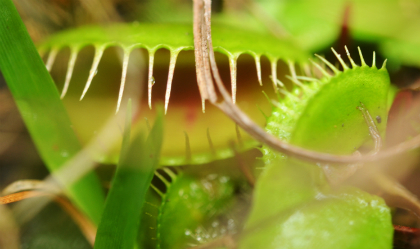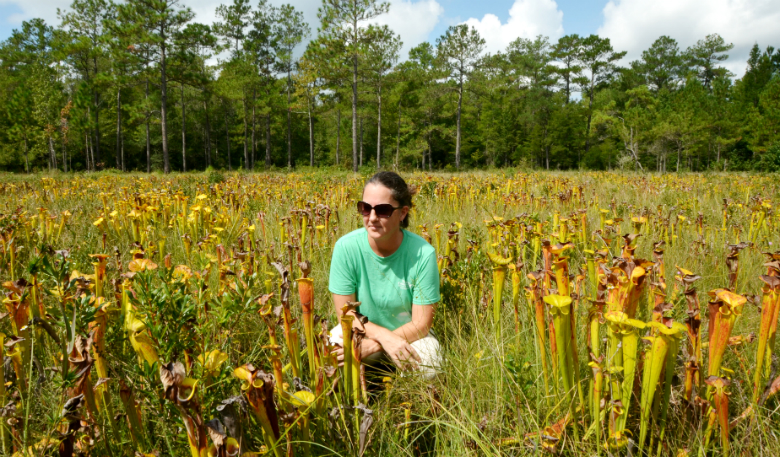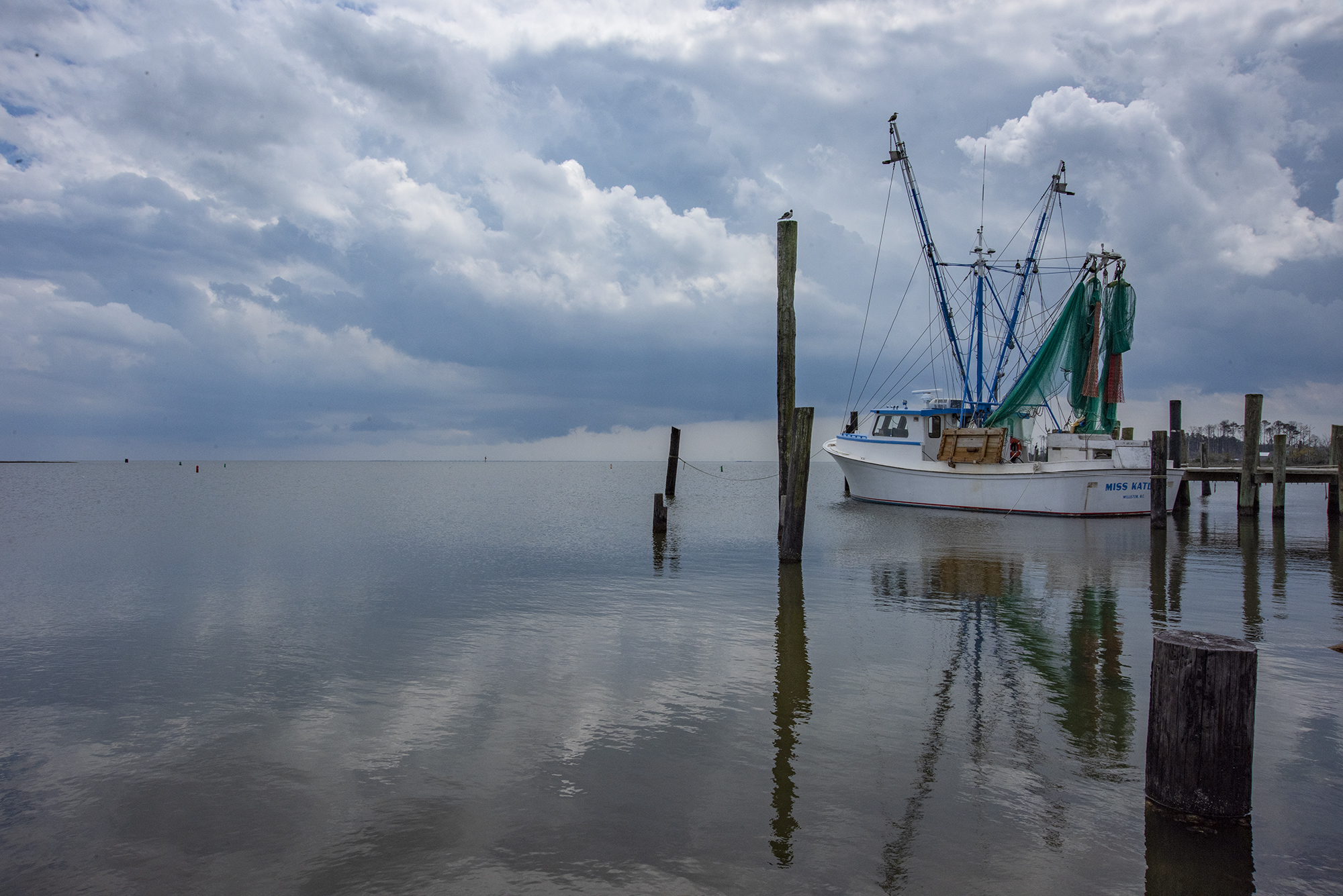 The Venus flytraps lures, kills and digests bugs. The only place in the world the carnivorous plant grows in the wild is within a 90-mile radius of Wilmington. The conservation of the rare plant depends on the state, which is why it will be a felony to steal them, punishable by up to 25 months in prison. Photo: Tess Malijenovsky |
On Dec. 1 it will become a felony in North Carolina to poach Venus flytraps from the wild, punishable by up to 25 months in prison.
Unlike most plants, the Venus flytrap (Dionaea muscipula) moves. It secretes a sweet-smelling nectar that drips on its guard hairs the way saliva drips from fangs. When trigger hairs on its yellow, sometimes ruby-colored, tongue are hit twice in a row, the flytrap snaps its teethed leaves like a bear trap within a tenth of a second, imprisoning its prey and absorbing the nutrients slowly.
Supporter Spotlight
Unless you’ve ever seen one, you might have larger-than-life expectations for the plant villainized by the 1960 film “Little Shop of Horrors” as a discreet yet ferocious flesh-eater. In the wild, however, their bright green, football-shaped heads that can eat bugs are hardly an inch wide. After opening and closing just a few times, the flytrap dies.
The only place in the world that Venus flytraps grow in the wild is within a 90-mile radius of Wilmington.
For that reason, its conservation in the wild depends on North Carolina. Rep. Ted Davis, Jr., reached out to the N.C. Coastal Land Trust and The Nature Conservancy to help in their conservation efforts for the flytrap. He introduced a bill in New Hanover County to make the theft of Venus flytraps a class H felony, which quickly gained popularity with four neighboring counties. The bill provision then went on to pass through both legislative chambers as a statewide law.
“I was happy to do it,” says Rep. Ted Davis, Jr. “First and foremost, I was born and raised in New Hanover County. I was familiar with the Venus flytrap being there, the uniqueness of the plant, in fact it eats bugs and flies to survive, and also how rare it is. If that thing is gone from its natural habitat…that’s it.”
In the last two years more than 11,000 Venus flytraps have been stolen in North Carolina, which is nearly a third of the amount estimated to be left in the wild. Under current law, taking flytraps from the wild is practically a slap on the wrist — a misdemeanor charge with a fine of $10, $50 at most. This has done little to deter repeat offenders.
Supporter Spotlight
Though the plant’s greatest threats are habitat destruction from development and fire suppression, they’re being assaulted by poachers in the very areas where they’re protected, like the Green Swamp in Brunswick County, which is preserved by The Nature Conservancy.
“We’re getting hit really hard, all the time, especially in the Green Swamp,” says Angie Carl, a fire specialist and land manager for the conservancy. “Poachers have altered the landscape they’ve taken so many.”
Divot marks in the soil where the thieves have used spoons or shovels to remove the bulbs are a dead giveaway combined with the plants’ disappearance. Some also leave markers like plastic bottles.
 In the past two years, over 11,000 Venus flytraps have been stolen, which is nearly a third of the amount estimated to be left in the wild. The plant is so small, poachers can easily fit several hundred in a pillow case. Photo: Tess Malijenovsky |
There are only three viable populations of Venus flytraps left in the wild, Carl says: the Green Swamp, Camp Lejeune and Croatan National Forest. The public can see them at Carolina Beach State Park, the N.C. Aquarium at Fort Fisher and botanical parks like the Stanley Rehder Carnivorous Plant Garden in Wilmington, too.
“This place is a little hidden gem,” Carl says, en route to one of the properties she manages that isn’t open to the public. “The population of Venus flytraps here isn’t nearly what it is in the Green Swamp, but it hasn’t really been poached like the Green Swamp has,” she says.
The black, all-wheel-drive truck rocks up and down through the wet terrain. The beauty of coastal bogs and pine savannahs in North Carolina is a subtle one, but after a prescribed burn, Carl says, “at that point it’s not subtle. It’s spectacular.”
The soil here is acidic and offers few essential plant nutrients, which is why the flytrap evolved its carnivorous diet. Like other plants, the Venus flytrap also makes food through photosynthesis but depends on insects for its source of nitrogen and phosphorus.
In an open field ablaze with thousands of golden-lime pitcher plants, Carl crouches down and starts combing the grassy brush for the flytraps. She notes all the varieties of carnivorous plants around her: the bladderworts, the butterworts, the sundews, the tall pitcher plants, the mauve squatty ones and their hybrids. Finally, after several minutes, she begins to see the strange, small plant everywhere.
Managing 40,000 acres of land makes it difficult for Carl to catch poachers in the act, which is why she often depends on witnesses like hunters who notify game officers of suspicious activity.
“When we catch people, they have thousands in their bag,” Carl says. A pillow case can fit as many.
Venus flytraps are sold on the black market to private nurseries for 10 to 25 cents a seed. The retail value of a thousand plants may be $20,000, but the thieves are hardly getting any return on their hard work.
“When we catch them, a lot of times they’re drenched in sweat,” says Matt Criscoe, a game officer for the N.C. Wildlife Resource Commission. “It’s not like they’re making a fortune doing it. That’s what we don’t really understand.
“I think they consider it a safe gamble: The payoff is worth the risk.”
“A lot of people that we’ve got are on the lower end of the poverty spectrum and probably have some addictions would be my guess,” Carl says. “They’re just supporting their habits.”
 Angie Carl, a land manager for The Nature Conservancy, sits among a field of thousands of pitcher plants in Pender County. This is where she finds the rare Venus flytrap, which has adapted to its acidic, low-nutrient habitat by luring, killing and digesting bugs. Photo: Tess Malijenovsky |
Also, extract of the Venus flytrap is thought to have 17 immune-supporting compounds, which some advertise as a cure for cancer.
“It’s kind of like one of these scams of rhino horns and ivory. Whatever is rare people sort of imbue with amazing properties,” says Camilla Herlevich, founder and executive director of N.C. Coastal Land Trust.
When over a thousand flytraps went missing from the Stanley Rehder Carnivorous Plant Garden in Wilmington in May, 2013, the N.C. Coastal Land Trust, which owns the conservation easement of the park, decided to step up and address the problem.
“We started talking to people at the state of North Carolina and to The Nature Conservancy and to Rep. Ted Davis, Jr., who actually called us and asked what he could do to help,” said Herlevich.
“What wildlife officers and prosecutors and judges have told us is that the penalties aren’t strong enough to deter criminals, and they don’t really justify a large investigation because typically there’s not much of a penalty,” she said.
It’s not illegal to own Venus flytraps, nor is it illegal to sell them. Only the act of stealing them from the wild is illegal, which can be difficult to prosecute, according to Linda Rawley, spokeswoman for the Wilmington Police Department.
“It’s very difficult,” Rawley says. “There’s no witnesses; and if we found the [stolen] plants, how can we tell where they came from?”
The hope is that a more severe penalty will deter the crime all together. “If they get caught now, they’ll get arrested,” says Criscoe. “With a felony charge comes a lot of restrictions in life.”
Needless to say, conservationists are praising the new law. “We spend millions and millions of dollars to protect these lands,” says Carl, “mostly because the flytrap is our North Carolina heritage.”







